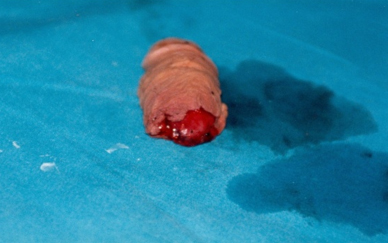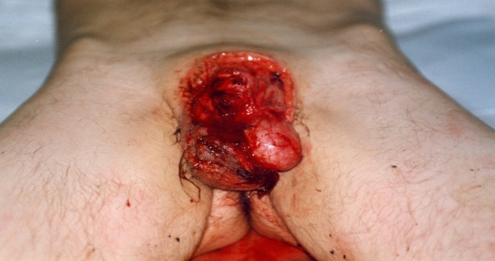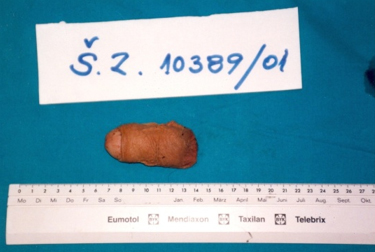|
||||||||||||||||||||||||||||||||||||
| [
Contents
] [ INDEX ]
|
||||||||||||||||||||||||||||||||||||
|
Page 159 |
||||||||||||||||||||||||||||||||||||
|
Case report Self-mutilation in urologic patients - review
article |
||||||||||||||||||||||||||||||||||||
|
|
||||||||||||||||||||||||||||||||||||
| Download in pdf format | Summary:
Self-mutilation is intentionally injuring oneself. Generally, the
most common self-inflicted wounds are burns and cuts which can be
closed and open. In extreme cases it could be a suicidal attempt. In
urology, genitals are usually the object of mutilation. Because of
their anatomical features and topographic location, they are most
commonly exposed to these procedures. There may be cuts on the
penis, perineum, scrotum; scrotum avulsion, orhiectomia, castration
to penile amputation. These are mental patients suffering from
paranioid schizophrenia. As part of their delusions, they have
bodily-cinesthetic hallucinations that manifest discomfort in the
genital area. There is a delusional idea that the only solution to
eliminate the hallucinations present is to self-mutilate. Because
these organs are very blood-borne, they are always shocked after the
ritual because of bleeding and pain. We present a 46-year-old
patient with severe genital injury, scrotum avulsion, and subtotal
penile amputation. Since more than 2 hours had passed since
self-mutilation, the suture of the penis could not be done, so after
resuscitation, a suture of the scrotum, tunica albuginae and an
external urethral opening were done. After leaving the recovery
room, he was transferred to a psychiatric ward and later to a higher
health care facility. Key Words: paranoid schizophrenia, self-mutilation, penis amputation. |
|||||||||||||||||||||||||||||||||||
INTRODUCTIONSelf-mutilation represents intentionally injuring oneself. Most
frequently these are cuts or burns.It is often a way for a person to
deal with emotional problems. Figure 1. Complete amputation
The penis is an organ which is anatomically divided into three
parts:the base of the penis, the shaft of the penis and the glans
penis. The base is located below the pubic bone and it provides the
firmness of the penis in erection. The shaft consists of two
cavernous parts and one spongy part. The urethra runs through the
spongy part to the external urethral orifice – meatus, located at
the tip of the glans penis. They are also called erectile bodies
because they enable erection of the penis. The glans is a distal
expansion of the spongy part covered with mobile skin – Prepuce. SHEMA 1. ANATHOMICAL DETAILS: VASCULARISATION OF PENIS AND TRANSVERSAL SECTION OF PENIS.
Open injuries of the penis are most often inflicted with firearms
or sidearms. Complete or total amputation is characterized by
cutting the cavernous parts and the urethra. CASE STUDY46 years old man, from around Zaječar, came to the urology
department in the morning, accompanied by his father. Pale, in poor
general condition. At the reception the father takes a nylon bag
from his pocket which contained a cut off penis. Examination under
cotton-wool soaked with blood reveals an open wound with the left
testicle outside the scrotum and subtotal amputation of the penis.
Urgent laboratory showed haemoglobin to be 72 g/l. In
heteroanamnesis, Patient is divorced, has a 17-year-old son who
lives with his mother while he himself lives with his parents. He
had been treated from schizophrenia for a long time and kept calling
himself Zorana. The day before he came to the department he put a
mirror in front of himself at the height of his genitalia andwith a
slashing knife began to rearrange his gender identity (Figures 2 and
3). Accidentally his mother came into his room finding him in the
pool of blood. Figure 2. Amputation of the penis and open wound of the scrotum.
Figure 3. Amputated part of the penis.
DISCUSSIONAll sexual actions including those sexually deviant which can
result in mutilation of genitalia take shape in the brain [1]. The
wounds can be closed and open. Closed wounds on the penis take place
accidentally during sex when the penis is in erection (Penile
fracture), because of the rupture of tunicae albuginae blood from
the cavernous part forms a hematoma subcutaneously. Open wounds can
come from the other person or very rarely in self-mutilation from
cuts on the scrotum (with cutting off of the sheaths with testicles
outside the scrotal sac), cuts on the penis, amputation of the
penis. Through careful anamnesis one can get to know the causes of
the injury. Depending on the objective findings therapy is
introduced. Injuries on the scrotum are repaired – after refreshing
the edges and hemostasis, if the testicles are outside the scrotum,
they return to the scrotal sac, the sheathsare sutured, there
follows subcutaneous drainage and suture of the skin. If it's been
less than 2 hours since the amputation, it is possible to perform a
suture with microsurgery in higher professional institutions [6,7].
In other cases, after resuscitation, proper hemostasis and urethral
restitution for normal urinationshould be performed. CONCLUSIONWe have presented an extremely rare case of self-harm.
Restitution of the severed penis was not attempted, as more than 2
hours had passed from the moment of penis cut-off to the arrival at
the urology department. The bleeding was not more copious because
the penis was not in erection. REFERENCES:
|
||||||||||||||||||||||||||||||||||||
|
|
||||||||||||||||||||||||||||||||||||
| [
Contents
] [ INDEX ]
|
||||||||||||||||||||||||||||||||||||
|
||||||||||||||||||||||||||||||||||||




